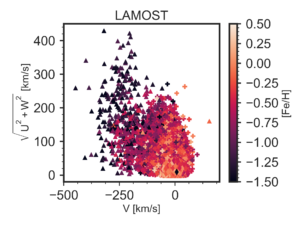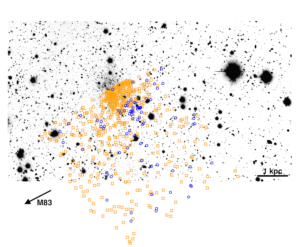The Milky Way, my favorite galaxy
Our very own Milky Way is a unique astrophysical laboratory for galaxy formation because of the unprecedented details provided by its individual stars. This field of astrophysical research is called Galactic Archaeology, where stars serve as a fossil record because we have information on their chemistry, kinematics, and for some, even ages. No other galaxy in the Universe provides us with this wealth of data! As a Galactic archaeologist, I combine the power of observations and simulations to investigate (1) the assembly history of our own galaxy, and (2) the population and evolution of satellite galaxies, to ultimately (3) understand how galaxies form, interact with each other, and evolve over time. If you are interested in any of these topics, please come chat with me!

Galactic Archaeology
Chemical abundances of accreted stellar halo stars
The hierarchical model of galaxy formation predicts the streams and tails of disrupted satellites that we see in observations and simulations. These are signatures of small galaxies being eaten by a bigger galaxy (ours truly) but these only show the current interactions of these systems. For the galaxies that have been fully disrupted and incorporated in the Milky Way though, we are still able to separate them out using chemistry and kinematics!
I have led and taken observations at the McDonald Observatory to look at such cannibalized stars from the Gaia-Enceladus/Gaia-Sausage/blob (GES) system to perform detailed chemical abundance analysis and ultimately to answer the following questions: How does this system compare to the satellite population of the Milky Way, both disrupted and undisrupted? What can its chemistry tell us about its star formation history and chemical evolution?
Here’s a link to the culmination of this work where I derived abundances in the alpha, light, odd-Z, iron-peak, and neutron-capture elements for GES stars!
Accreted halo stars in the simulations
Summary coming soon*! In the meantime, here’s the link to the paper.
The Milky Way disk
Summary coming soon*! In the meantime, here’s the link to my paper on the ages and abundances of disk stars in the simulations and the link to the paper led by my amazing student Kaile Wang (UT ’23) on the birth radius of disk stars.
*Please come chat with me in the mean time if you are interested to know more!
Other research work**
**In order of distance from us
Know thy star, know thy planet: chemo-kinematically characterizing possible planet-hosting stars
Link to catalog used in the paper: zenodo
Link to the paper: arXiv

 Toomre diagrams of stars crossmatched with TESS CTL, Gaia DR2 (with radial velocity), and LAMOST, color-coded by [alpha/Fe] (left) and [Fe/H] (right). Triangles mark halo stars, pluses are thick disk stars, and diamonds are thin disk stars.
Toomre diagrams of stars crossmatched with TESS CTL, Gaia DR2 (with radial velocity), and LAMOST, color-coded by [alpha/Fe] (left) and [Fe/H] (right). Triangles mark halo stars, pluses are thick disk stars, and diamonds are thin disk stars.
With the advent of the Transiting Exoplanet Survey Satellite, we will be able to find thousands of exoplanets around stars of different chemistry, kinematics, and location in the Milky Way. As the same gas that forms stars forms the planets around them, it is important to understand how planet properties relate to stellar properties. I investigated the Galactic context of planet populations and formation by combining astrometric, spectroscopic, and photometric surveys (i.e. Gaia DR2, APOGEE, GALAH, RAVE, LAMOST, Skymapper) to understand the chemo-kinematics of possible planet-hosting stars. We find that most TESS targets are in the thin disk (>90%), but they are also found in the thick disk (4%) and the halo (<1%). We then used these kinematic memberships and looked at the metallicity and alpha-enhancement in the different Galactic components from the variety of surveys we utilized for the study. We find that each survey shows decreasing metallicity and increasing alpha-enhancement as one goes from the thin disk to the halo. We hope this catalog (linked above!) will be useful to explore planet populations as a function of kinematics, component-membership, metallicity, and alpha content.
Spatially-resolved stellar populations outside Milky Way
Link to paper: arXiv

Determining the stellar population properties in other galaxies is made difficult by the fact that we are not able to resolve each star like we can in the Milky Way. We know that our Galaxy has different components that have different types of stellar populations and formation history. How do we do this for other galaxies?
Answer: we use spatially-resolved data from integral field spectroscopy (IFS/IFU for short)! With IFU data, we are able to observe the spectra of a galaxy in different regions and figure out what combination of stellar populations give rise to the observed integrated light. In a recently submitted paper, I derived the stellar population ages and metallicities of the galaxy NGC 2903 using the VENGA IFU survey in its different parts: the bulge, the bar, and the disk. I calculated the mass build up in each of the different galaxy component and find that (1) most of the bulge mass has formed at earlier times compared to the bar and the disk and that (2) the bar and the disk have similar mass build up histories, pointing to the scenario that the bar is formed from disk material.
Dwarf galaxies outside the Local Group
Link to the paper: arXiv


I have grown to appreciate and understand the importance of dwarf galaxies in undergrad and this research topic is still definitely one my favorites so I hope to one day get back to it! Understanding the census of dwarf galaxies around big galaxies like the Milky Way help constrain our simulations and understanding of cosmology and galaxy formation.
For the undergrad paper I led under the mentorship of Eric Bell, I characterized the dwarf galaxy dw1335-29 using VLT VIMOS images and HST photometry from the Galaxy Halos, Outer Disks, Substructure, Thick Disks, and Star Clusters survey (GHOSTS). I used the tip of the red giant branch method to confirm the dwarf galaxy’s membership to the M83 group. It’s a peculiarly star-forming and non-tidally disrupted galaxy at a 26 kpc projected distance to its host. This is weird compared to the Milky Way satellite population which is mostly quiescent for those within 100 kpc (barring the Magellanic Clouds) and has dwarf galaxies disrupted and spread across the stellar halo at distances of 30 kpc like Sagittarius.
Collaborators and Mentors
Alis Deason – Postdoc advisor
Keith Hawkins – UT research advisor
Melissa Ness – CCA advisor
Niv Drory – UT research advisor
Eric Bell – UM research advisor and mentor
Undergrad research mentees:
- Rian Robison – UT undergrad (2019 – 2021)
- Joel Burke – UT undergrad (2019), current grad student at Notre Dame (2022)
- Maya Sinha – UT undergrad (2019 – 2020), current grad student at University of Utah (2021)
- Kaile Wang – UT undergrad (2020 – 2023), current grad student at UT Austin (2023)
- Natasha Judson-Richardson – Durham Masters student (2022 – 2023)
- Thomas Tomlinson – Durham Masters student (2022-2023), current grad student at Durham (2023)
